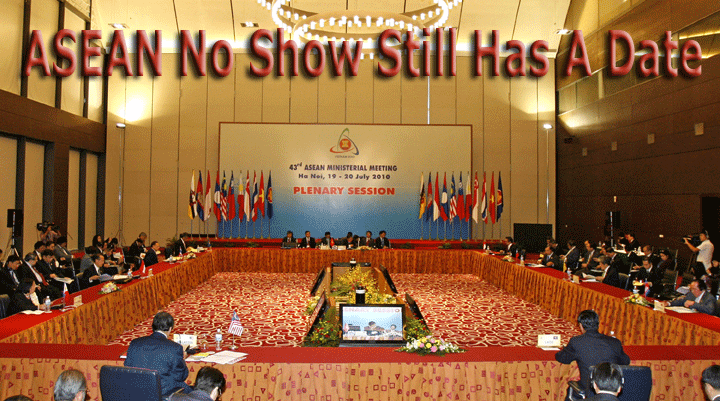 Although
from the seating arrangements pictured here some may have needed binoculars
to see each other, Foreign Ministers from 10 Association of Southeast
Asian Nations (ASEAN) met in Hanoi in July 2010. Right now the delayed
launch of the ASEAN Economic Community is a blow to the region’s
airlines, manufacturers, and 3PLs. But most remain optimistic that AEC
can eventually deliver on its potential. Although
from the seating arrangements pictured here some may have needed binoculars
to see each other, Foreign Ministers from 10 Association of Southeast
Asian Nations (ASEAN) met in Hanoi in July 2010. Right now the delayed
launch of the ASEAN Economic Community is a blow to the region’s
airlines, manufacturers, and 3PLs. But most remain optimistic that AEC
can eventually deliver on its potential.
January 1 was supposed
to be the day when ten South East Asian nations with a combined population
of over 600 million people and GDP of $2.5 trillion took their collective
places among the heavyweights of world trade by creating the ASEAN Economic
Community, Asia’s version of the European Union.
But January 1 came and went. ASEAN’s
members collectively shrugged their shoulders and simply announced a new
deadline of December 31, although not many in the private sector or government
expect this to be stuck to either. But the delays do not diminish the
potential that AEC has to boost the economies of South East Asia and their
place in the global trading system.
The aims of AEC are much like those of the
European Union: to create a single market for goods and services by opening
borders, removing tariffs, and harmonizing regulations. As well as creating
a single open skies aviation market, once implemented the facilitation
of international truck movements offers the potential for integrators
to create vast regional distribution centers linked globally by freighter
services and offering rapid deliveries over large distances by truck and
air, much like they already offer in Europe and North America.
These networks would not only serve mushrooming
domestic demand in places such as Vietnam, Indonesia, and Malaysia for
foreign imports, they would also provide the crucial supply chain infrastructure
needed for manufacturers attracted to AEC by its huge domestic market
and—in many member states—low labor and land costs: the basic
raw materials needed for mass production manufacturing aimed at export
markets.
The ASEAN secretariat claims that some 80
percent of AEC’s goals have been achieved already. Those in the
transport world tell a different story. Although many tariffs have been
removed, trading across borders remains difficult and bureaucratic—customs
and regulatory regimes are far from harmonized. Where there have been
improvements, many put this down to successful bilateral agreements rather
than ASEAN reforms.
Certainly, the pace of change is hugely
variable, reflecting the vastly different social, political, and economic
models and wealth of ASEAN’s members—Brunei Darussalam, Cambodia,
Indonesia, Laos, Malaysia, Myanmar, Philippines, Singapore, Thailand,
and Vietnam.
For many in the air cargo sector, the big
opportunity of AEC is derived from its stated policy of open skies. In
theory, the creation of a single aviation market will create huge new
opportunities for airlines, service providers, and logistics planners.
A pure open skies environment with no limits on slots and routings will
likely remain elusive after 2015, but airports and airlines around the
region are already investing in new terminals and planes in anticipation
of accelerated demand for freight and passenger movements.
 Sou
Ping Chee, (right) regional head of air freight Asia Pacific at Panalpina,
said the AEC Open Skies policy was definitely a move in the right direction,
although the impact in the short term would be minimal. Sou
Ping Chee, (right) regional head of air freight Asia Pacific at Panalpina,
said the AEC Open Skies policy was definitely a move in the right direction,
although the impact in the short term would be minimal.
“First, full implementation of AEC
Open Skies will only happen by end-2015,” said the Singapore-based
executive. “Second, AEC Open Skies has its limitations as it does
not bring full liberalization. For example, it will not allow a third
carrier to fly between two foreign countries or to operate on a domestic
route in a foreign country.
“So a certain level of protectionism
is still there and consequently we have not seen any major production
or planning shift in the ASEAN community so far ahead of the year-end.”
 But
elsewhere optimism is running high. Richard Strollo, (left) managing director,
South Asia, BDP International, said the gradual implementation of free
trade policy via the creation of AEC would be of huge benefit economically
to the region. “Certainly our customers are reviewing developments
and we are also keeping them updated with information and consultations
for their logistics needs,” he said. “From
an air freight perspective, Open Skies will be welcome, enabling more
flexibly to offer our air freight customers improved transit times. All
in all this is a step forward to help our customers grow in South East
Asia.” But
elsewhere optimism is running high. Richard Strollo, (left) managing director,
South Asia, BDP International, said the gradual implementation of free
trade policy via the creation of AEC would be of huge benefit economically
to the region. “Certainly our customers are reviewing developments
and we are also keeping them updated with information and consultations
for their logistics needs,” he said. “From
an air freight perspective, Open Skies will be welcome, enabling more
flexibly to offer our air freight customers improved transit times. All
in all this is a step forward to help our customers grow in South East
Asia.”
 Michael
Drake, (rightt) managing director, TNT Asia, Middle East & Africa,
said TNT was not expecting a “Big Bang” impact from an ASEAN
single market at the end of this year, citing “challenges to full
implementation.” But he claimed there were already real trading
wins accruing from the reform process. Michael
Drake, (rightt) managing director, TNT Asia, Middle East & Africa,
said TNT was not expecting a “Big Bang” impact from an ASEAN
single market at the end of this year, citing “challenges to full
implementation.” But he claimed there were already real trading
wins accruing from the reform process.
TNT has been pro-active in lobbying ASEAN
governments to accelerate the implementation of simpler customs documentation
procedures via the ASEAN Single Window. The company is also pushing for
adoption of electronic data interchange for customs declarations and risk
assessment systems to speed up the quick clearance and delivery of goods
across the region.
However, in many parts of the ASEAN bloc
these trade facilitation measures will take some time to implement. In
the meantime Drake is looking at the positives. “We are excited
by the potential possibilities that an ASEAN single market will bring,”
he said. “We are seeing some of benefits and real improvements in
achieving the goals of the AEC. For example, more than 70 percent of intra-ASEAN
trade incurs no tariff, which is good news for our customers.”
SkyKing |





